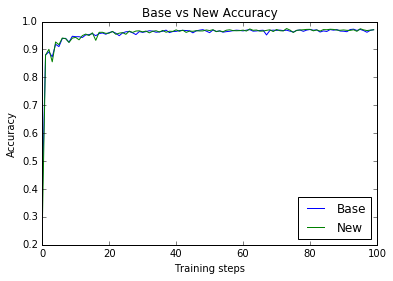The hidden layers in a neural network can be seen as different representations of the input. Do deeper layers learn “better” representations? In a network trained to solve a classification problem, this would mean that deeper layers provide better features than earlier layers. The natural hypothesis is that this is indeed the case. In this post, I test this hypothesis on an network with three hidden layers trained to classify the MNIST dataset. It is shown that deeper layers do in fact produce better representations of the input.
Model setup
1 | |
The network achieves an accuracy of about 97% after 10000 training steps in batches of 50 (about 1 epoch of the dataset).
Increasing representational power
To show increasing representational power, I run logistic regression (supervised) and PCA (unsupervised) models on each layer of the data and show that they perform progressively better with deeper layers.
1 | |
Logistic Regression
1 | |
Layer 0 accuracy is: 0.828 Layer 1 accuracy is: 0.931 Layer 2 accuracy is: 0.953 Layer 3 accuracy is: 0.966
1 | |
from sklearn.decomposition import PCA from matplotlib import cm def plot_mnist_pca(axis, x, ix1, ix2, colors, num=1000): pca = PCA() pca.fit(x) x_red = pca.transform(x) axis.scatter(x_red[:num,ix1],x_red[:num,ix2],c=colors[:1000],cmap=cm.rainbow_r)
def plot(list_to_plot): fig,ax = plt.subplots(3,4,figsize=(12,9)) fig.tight_layout() perms = [(0,1),(0,2),(1,2)] colors = y_test_single
index = np.zeros(colors.shape) for i in list_to_plot: index += (colors==i)
for row, axis_row in enumerate(ax): for col, axis in enumerate(axis_row): plot_mnist_pca(axis, x_arr_test[col][index==1], perms[row][0], perms[row][1], colors[index==1], num=1000)
plot(range(4))
1 | |
pca = PCA() l3_train = l3.eval(feed_dict={x:mnist.train.images}) l3_test = l3.eval(feed_dict={x:mnist.test.images})
pca.fit(l3_train) y_new_train = pca.transform(l3_train)[:,:3] y_new_test = pca.transform(l3_test)[:,:3]
saver.restore(sess, ‘/tmp/initial_variables.ckpt’)
create new placeholder for 3 new variables
y_3newfeatures_ = tf.placeholder(“float”, shape=[None, 3])
add linear regression for new features
w = weight_variable([100,3]) b = bias_variable([3]) y_3newfeatures = tf.matmul(l1,w) + b
sess.run(tf.initialize_all_variables())
new_feature_loss = 1e-1*tf.reduce_sum(tf.abs(y_3newfeatures_-y_3newfeatures))
train_step_new_features = tf.train.GradientDescentOptimizer(0.01).minimize(cross_entropy + new_feature_loss)
new_accuracy = [] for i in range(10000): start = (50*i) % 54950 end = start + 50 train_step_new_features.run(feed_dict={x: mnist.train.images[start:end], y_: mnist.train.labels[start:end],y_3newfeatures_:y_new_train[start:end]}) if i % 100 == 0: acc, ce, lr = sess.run([accuracy, cross_entropy, new_feature_loss],feed_dict={x:mnist.test.images,y_:mnist.test.labels,y_3newfeatures_:y_new_test}) new_accuracy.append(acc) print(“Accuracy: “ + str(acc) + “ – Cross entropy: “ + str(ce) + “ – New feature loss: “ + str(lr),end=”\r”)
print(new_accuracy[-1])
0.9707
1 | |
